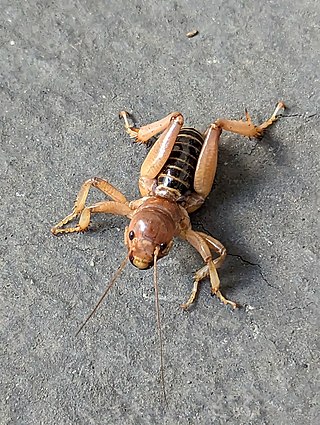
Anostostomatidae is a family of insects in the order Orthoptera, widely distributed in the southern hemisphere. It is named Mimnermidae or Henicidae in some taxonomies, and common names include king crickets in Australia and South Africa, and wētā in New Zealand. Prominent members include the Parktown prawn of South Africa, and the giant wētā of New Zealand.

The family Gryllidae contains the subfamilies and genera which entomologists now term true crickets. Having long, whip-like antennae, they belong to the Orthopteran suborder Ensifera, which has been greatly reduced in the last 100 years : taxa such as the spider-crickets and allies, sword-tail crickets, wood or ground crickets and scaly crickets have been elevated to family level. The type genus is Gryllus and the first use of the family name "Gryllidae" was by Francis Walker.

Stenopelmatus is one of two genera of large, flightless insects referred to commonly as Jerusalem crickets. They are primarily native to Central America, and one species is known from Ecuador.

Ensifera is a suborder of insects that includes the various types of crickets and their allies including: true crickets, camel crickets, bush crickets or katydids, grigs, weta and Cooloola monsters. This and the suborder Caelifera make up the order Orthoptera. Ensifera is believed to be a more ancient group than Caelifera, with its origins in the Carboniferous period, the split having occurred at the end of the Permian period. Unlike the Caelifera, the Ensifera contain numerous members that are partially carnivorous, feeding on other insects, as well as plants.

Stenopelmatidae is a family of large, mostly flightless orthopterans that includes the Jerusalem crickets. Two genera: Ammopelmatus and the type genus Stenopelmatus are found in the New World. Oryctopus and Sia are Old World genera, and previously placed in their own subfamilies, but with the addition of new genera, current placement is as five tribes in the single subfamily Stenopelmatinae.

Tetrigidae is an ancient family in the order Orthoptera, which also includes similar families such as crickets, grasshoppers, and their allies. Species within the Tetrigidae are variously called groundhoppers, pygmy grasshoppers, pygmy devils or "grouse locusts".

Ammopelmatus is a genus of insects in the family Stenopelmatidae, one of two genera of large, flightless insects referred to commonly as Jerusalem crickets. They are native to western United States and northwestern Mexico.
Ammopelmatus cahuilaensis is a species of insect in the family Stenopelmatidae. The species is found in the Coachella Valley and was described by Ernest R. Tinkham in 1968, in The Great Basin Naturalist.
Ammopelmatus navajo, commonly known as the Navajo Jerusalem cricket, is a species of nocturnal Jerusalem cricket in the family Stenopelmatidae. It is endemic to the United States, specifically Arizona, and found under rocks in loose soil. It is closely related to A. fuscus and they have nearly identical drumming patterns. They live one to two years as adults, but can die prematurely by parasitic infections, commonly by the horsehair worm.
Ammopelmatus nigrocapitatus is a species of insect in the family Stenopelmatidae. It is endemic to parts of Southern California.

Jerusalem crickets are a group of large, flightless insects in the genera Ammopelmatus and Stenopelmatus, together comprising the tribe Stenopelmatini. The former genus is native to the western United States and parts of Mexico, while the latter genus is from Central America.

The Phaneropterinae, the sickle-bearing bush crickets or leaf katydids, are a subfamily of insects within the family Tettigoniidae. Nearly 2,060 species in 85 genera throughout the world are known. They are also known as false katydids or round-headed katydids.

The Eneopterinae are a subfamily of crickets, in the family Gryllidae, based on the type genus Eneoptera. It is one of several groups widely described as "true crickets". Of the more than 500 species that make up this subfamily, most occur in moist, tropical habitats. These insects are medium to large and brown or gray in color. They eat plant leaves, flowers, and fruits and can occasionally cause economic damage. Their eggs are deposited in pith, bark, or wood. Eneopterinae show a great diversity in stridulatory apparatus, signals emitted, and associated behaviour.

Mecopodinae are a subfamily of bush crickets found in western South America, sub-Saharan Africa, and Asia. In Asia, the distribution includes India, Indochina, Japan, the Philippines, and Malesia to Papua New Guinea and Australasia, including many Pacific islands.

Stenopelmatoidea is a superfamily of insects in the order Orthoptera; in some older classifications this group was referred to as Gryllacridoidea.

Pamphagidae is a family of grasshoppers belonging to the superfamily Acridoidea. The species in this family can be found in Africa, Europe and Asia.

Conocephalinae, meaning "conical head", is an Orthopteran subfamily in the family Tettigoniidae.

Ammopelmatus pictus is a species of Jerusalem cricket in the family Stenopelmatidae. It is found in parts of the Central Valley, Diablo Range, and Silicon Valley within California.
Ammopelmatus longispina is a species of Jerusalem cricket in the family Stenopelmatidae. It is found in North America.













